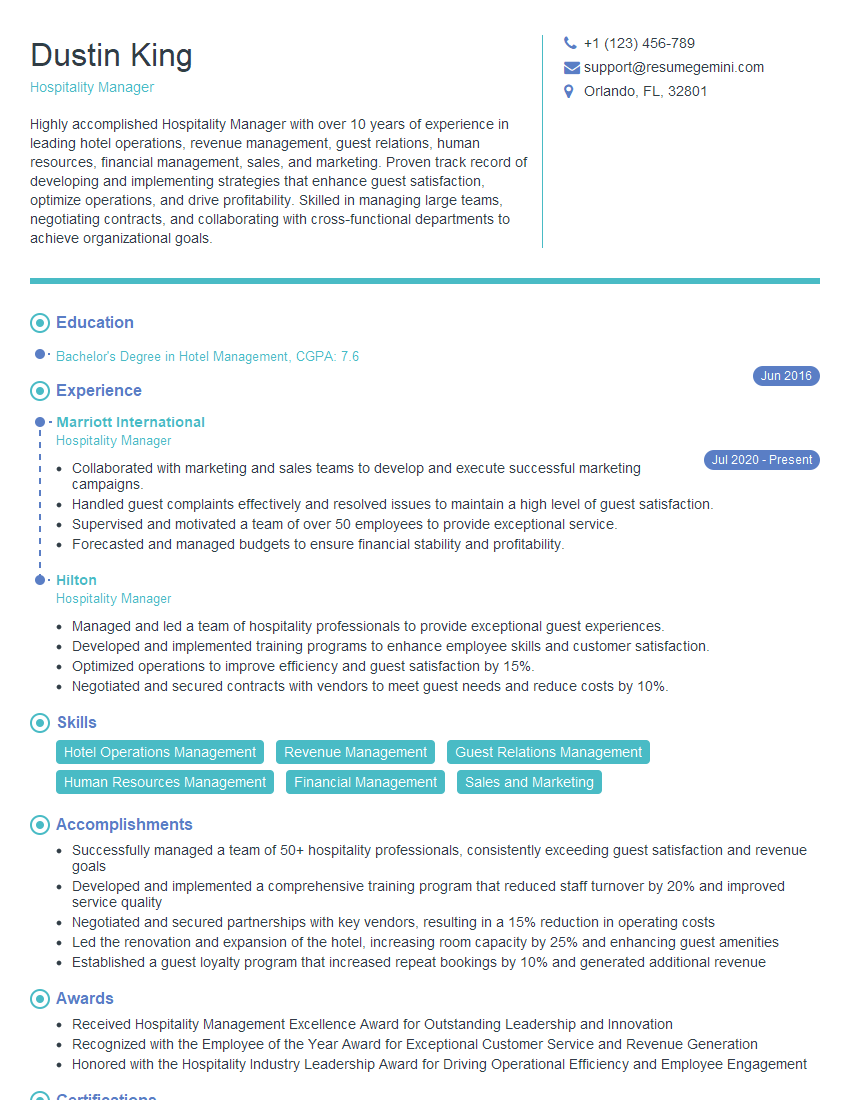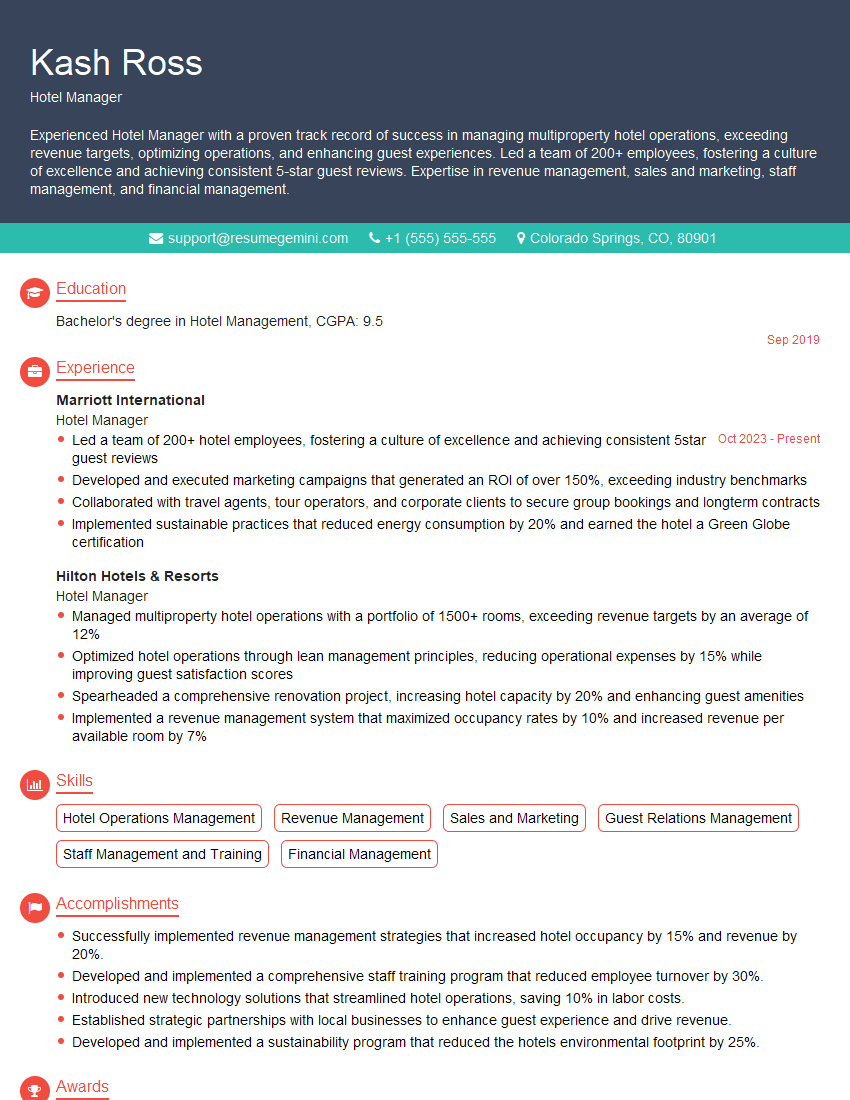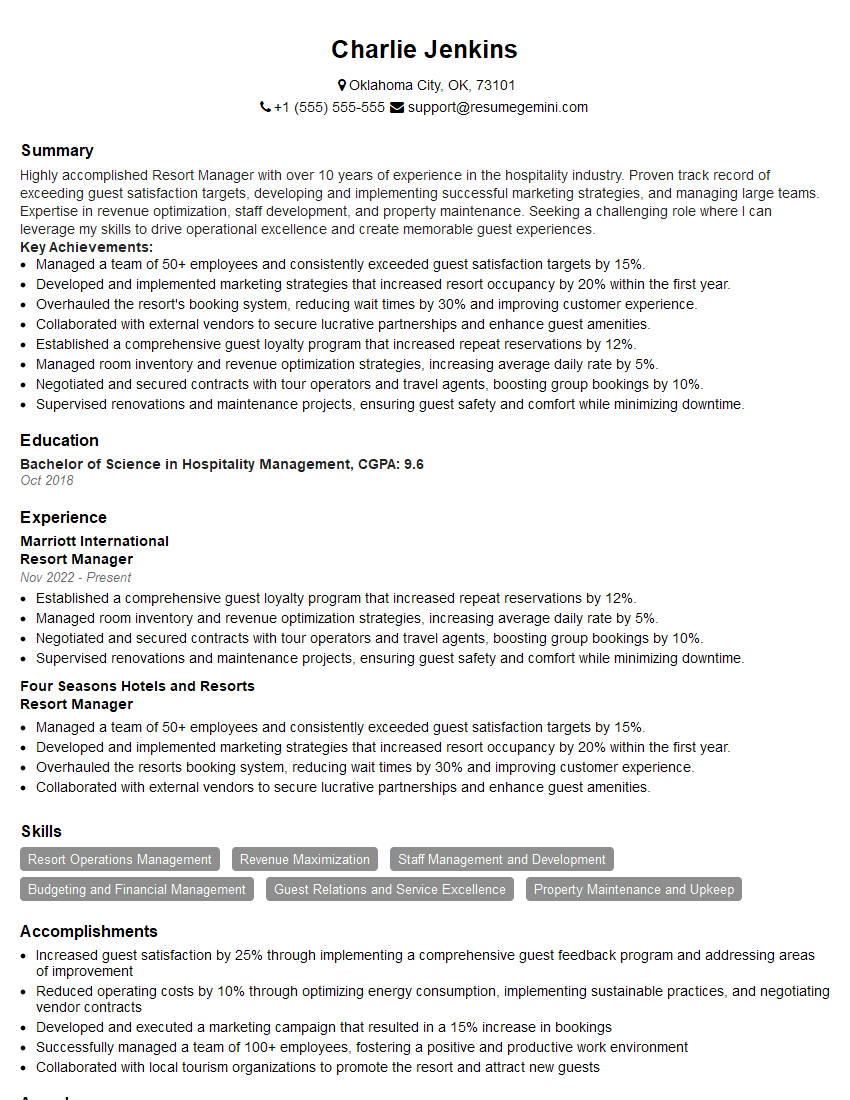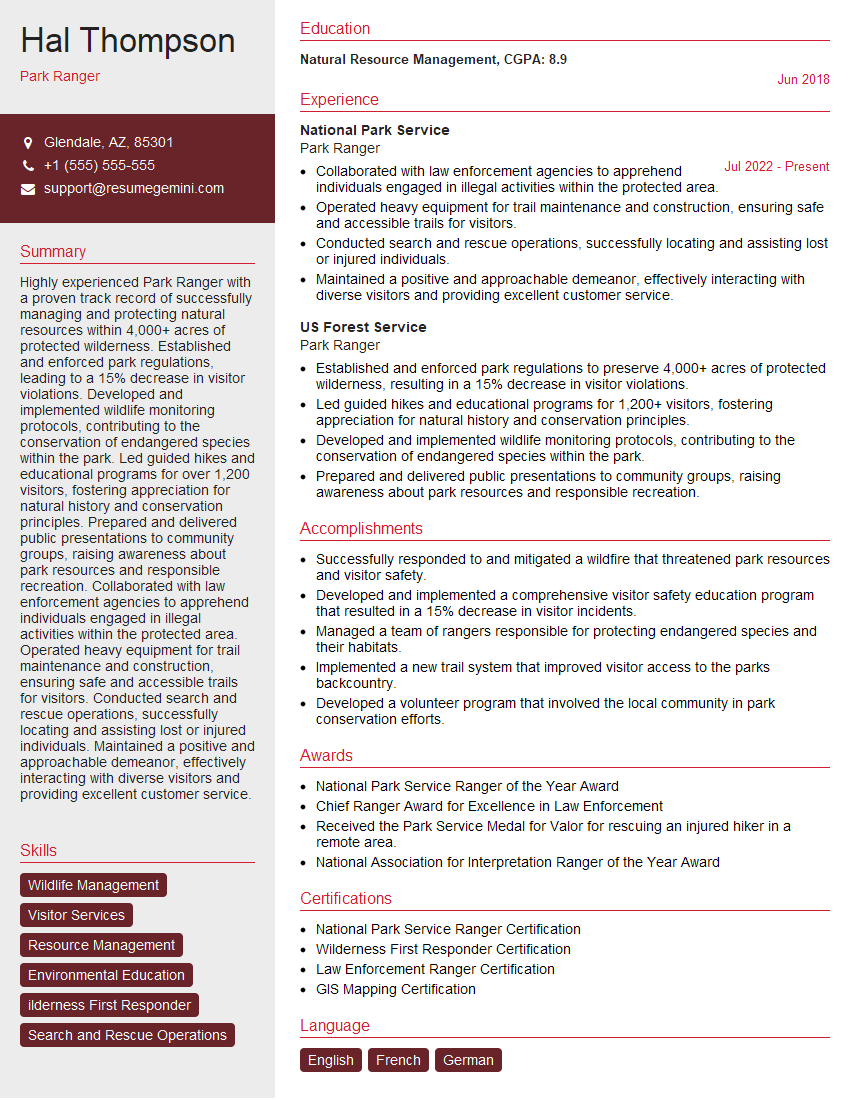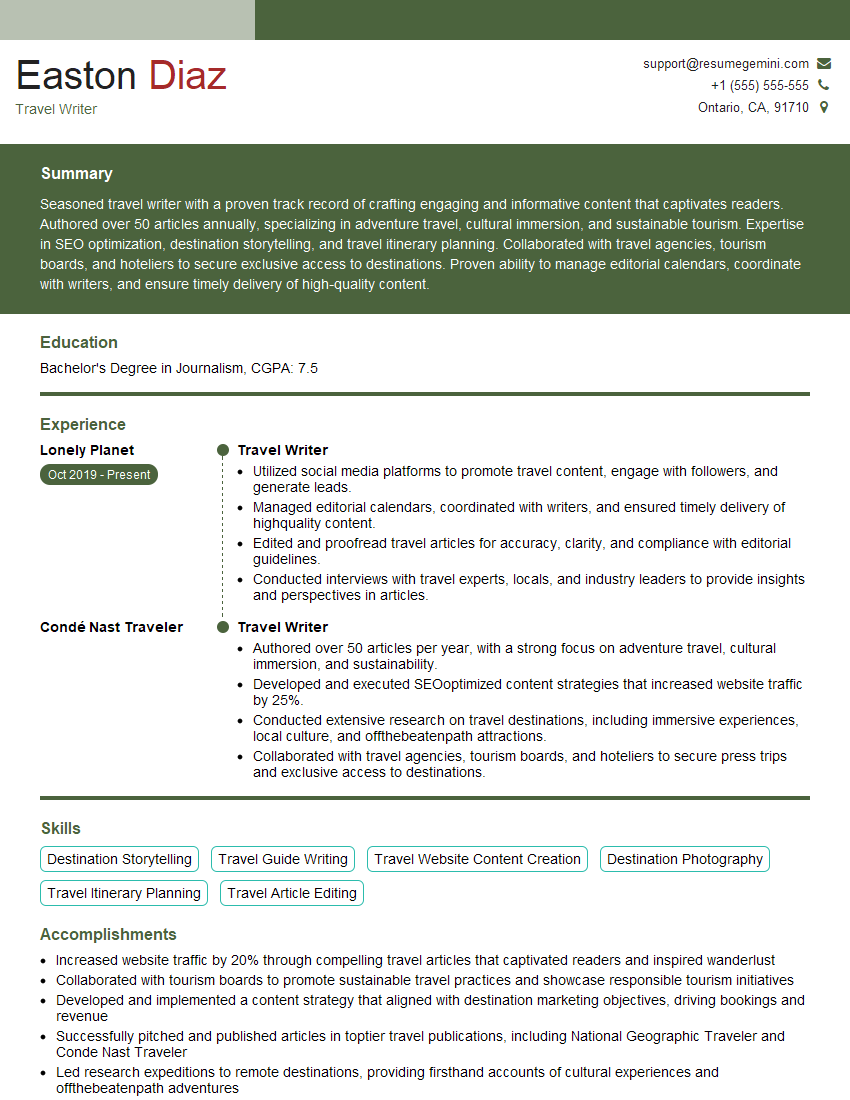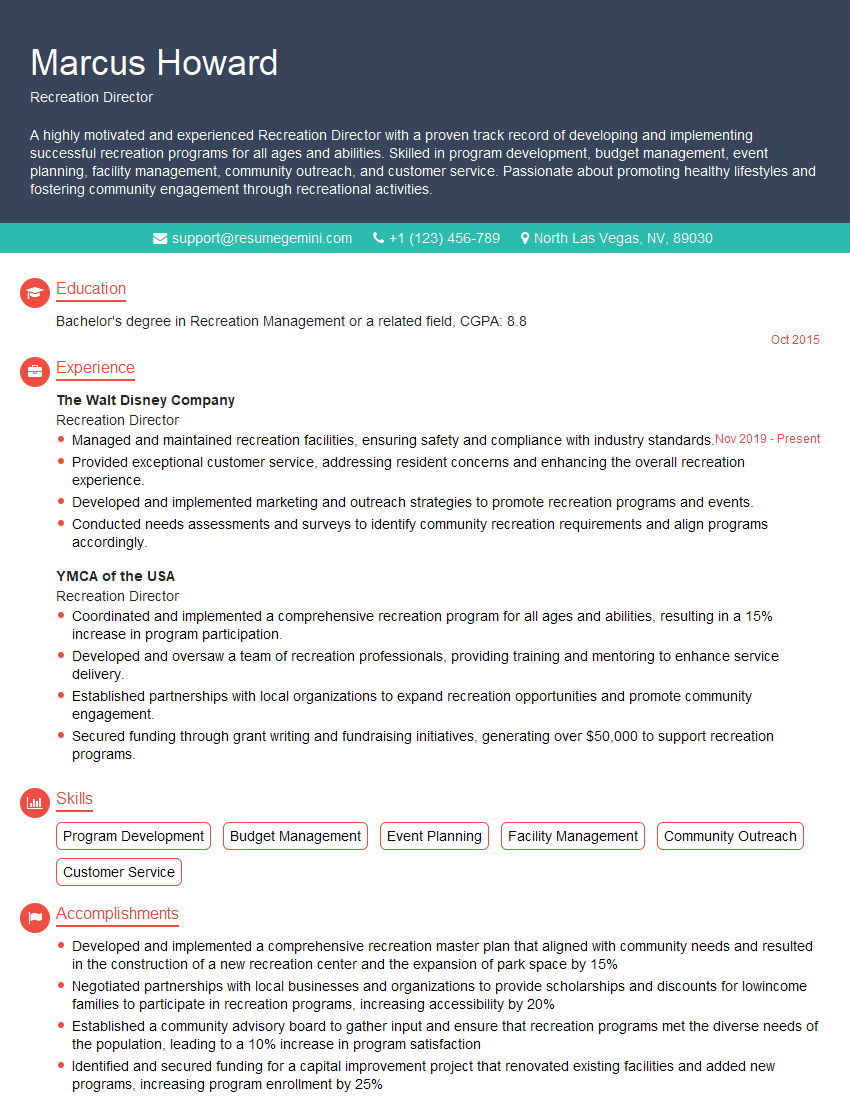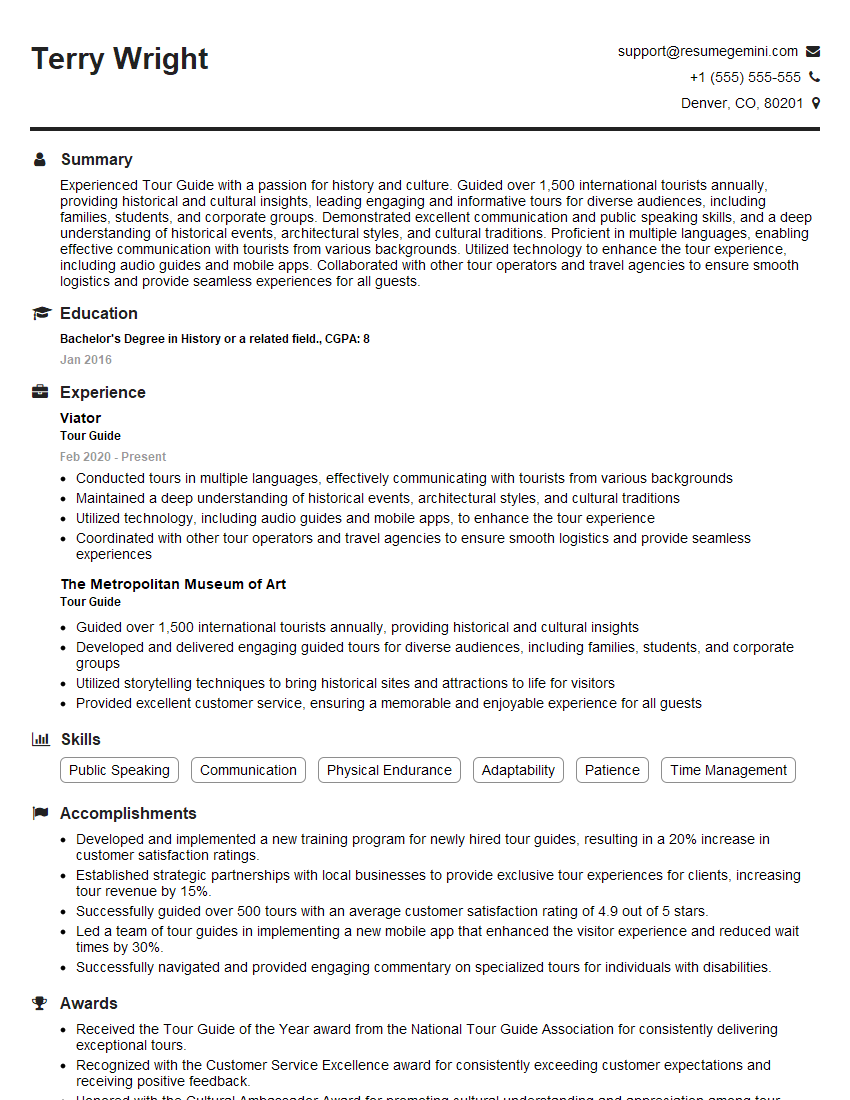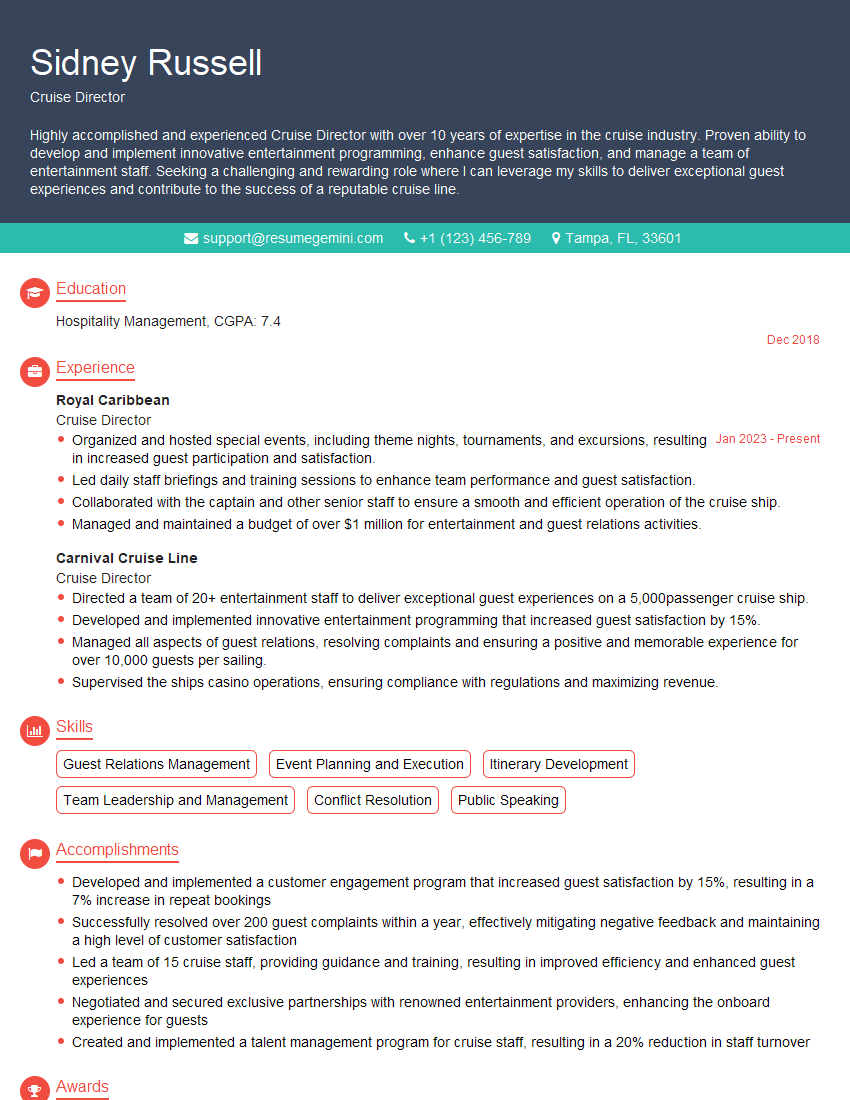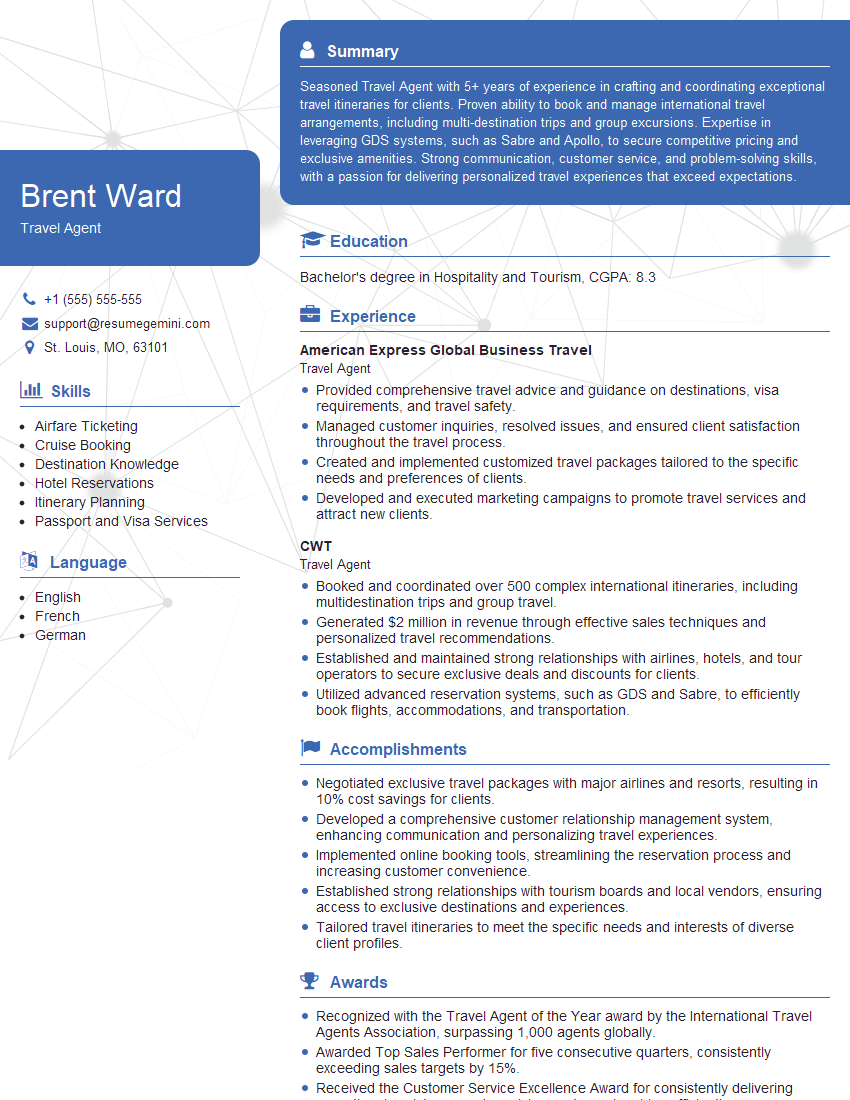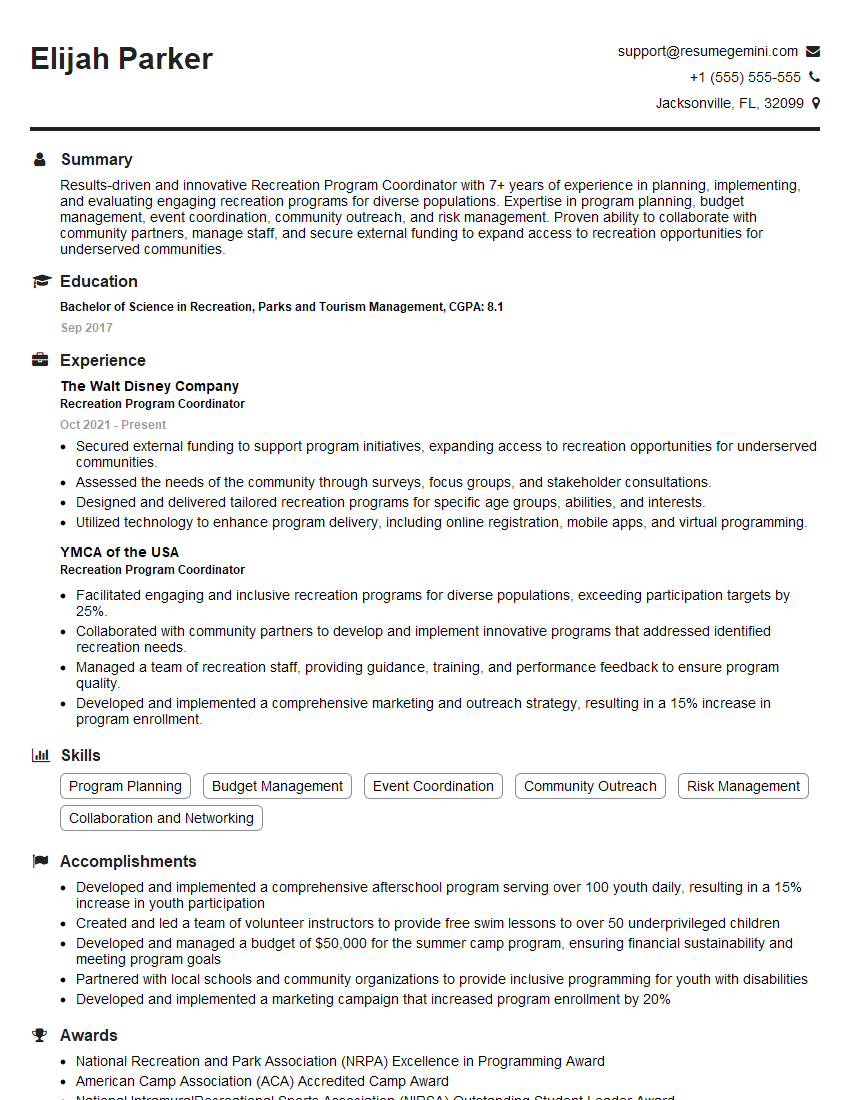The right preparation can turn an interview into an opportunity to showcase your expertise. This guide to Tourism and Recreation interview questions is your ultimate resource, providing key insights and tips to help you ace your responses and stand out as a top candidate.
Questions Asked in Tourism and Recreation Interview
Q 1. Explain your experience in developing and implementing tourism marketing strategies.
Developing and implementing successful tourism marketing strategies requires a multi-faceted approach. It begins with a deep understanding of the target market – their demographics, travel motivations, and preferred communication channels. Then, a compelling brand story needs to be crafted, highlighting the unique selling propositions of the destination or attraction. This might involve emphasizing natural beauty, cultural experiences, adventure activities, or historical significance.
For example, in my previous role promoting a coastal region, we identified our target audience as families seeking affordable beach vacations. Our strategy focused on family-friendly content on social media, partnerships with family travel bloggers, and discounted package deals emphasizing value for money. We also leveraged search engine optimization (SEO) to improve our online visibility for relevant keywords like ‘family beach holidays’ and ‘budget-friendly coastal getaways’. We meticulously tracked website traffic, social media engagement, and booking conversions to measure campaign effectiveness and make data-driven adjustments.
Furthermore, successful marketing involves a blend of online and offline strategies. This could include print advertising in relevant publications, participation in travel fairs and exhibitions, and collaborations with local businesses. Measuring the Return on Investment (ROI) of each channel is crucial for optimizing future marketing efforts.
Q 2. Describe your approach to managing customer service issues in a tourism setting.
Managing customer service issues in tourism is about prioritizing empathy and swift resolution. It’s about turning negative experiences into opportunities for loyalty. My approach is based on the principles of active listening, clear communication, and empowerment. I train staff to handle complaints with professionalism, patience, and a genuine desire to help. The first step is always to acknowledge the customer’s frustration and validate their feelings. Then, we work collaboratively to find a solution that meets their needs, while also protecting the interests of the business.
For instance, if a guest complains about a faulty room, we don’t just apologize; we offer immediate remediation, perhaps an upgrade or a discount on their stay. We follow up with a personal email, expressing our concern and assuring them of our commitment to their satisfaction. We then use the feedback to identify and address underlying issues that led to the complaint in the first place. We actively solicit feedback through surveys and reviews, both positive and negative, to continuously improve our service.
Q 3. How would you handle a crisis situation, such as a natural disaster, impacting tourism operations?
Handling a crisis like a natural disaster requires a well-rehearsed crisis communication plan. This plan should detail roles and responsibilities, communication channels, and escalation procedures. The first priority is ensuring the safety and well-being of tourists and staff. This involves immediate evacuation if necessary, provision of emergency supplies, and coordination with local emergency services. Simultaneously, we must establish clear and consistent communication with impacted tourists, providing regular updates and reassurance. This would be done through multiple channels such as email, social media, and possibly dedicated phone lines or websites.
Transparency is crucial. We need to honestly assess the situation and communicate potential impacts on travel plans. We should offer alternative arrangements where possible, such as rebooking or refunds. Finally, post-crisis, we would conduct a thorough review of our response, identifying areas for improvement and refining our crisis management plan. This might involve better early warning systems or more robust communication infrastructure.
Q 4. What are the key performance indicators (KPIs) you would use to measure the success of a tourism program?
Measuring the success of a tourism program relies on a range of Key Performance Indicators (KPIs). These should be aligned with the program’s objectives, which might include increasing visitor numbers, boosting local economic activity, or improving destination image. Some crucial KPIs include:
- Visitor numbers and demographics: Tracking the number of tourists, their origin, length of stay, and spending habits.
- Revenue generated: Measuring direct and indirect economic impact on the local economy, including hotel occupancy, restaurant sales, and tour operator revenue.
- Customer satisfaction: Analyzing feedback from surveys, online reviews, and social media sentiment.
- Website traffic and engagement: Assessing website analytics to understand online marketing effectiveness.
- Social media engagement: Monitoring likes, shares, comments, and brand mentions.
- Media coverage and brand awareness: Tracking media mentions and public perception of the destination.
By regularly monitoring these KPIs, we can gain valuable insights into the program’s performance, identify areas for improvement, and justify future funding and resource allocation.
Q 5. Discuss your experience with budget management in a tourism or recreation context.
Budget management in tourism is about balancing financial responsibility with the need for investment in quality experiences and infrastructure. My experience involves meticulous planning, forecasting, and monitoring. I typically begin by creating a detailed budget outlining anticipated revenues and expenses across various areas such as marketing, operations, staffing, and maintenance. This involves using forecasting models based on historical data and market trends.
During implementation, I actively monitor spending, comparing actual figures against the budget and identifying any variances. This might involve using budgeting software to track expenses and generate reports. If significant discrepancies arise, I investigate the causes and take corrective action, which could involve cost-cutting measures or reallocation of resources. Regular reporting to stakeholders keeps them informed of budget performance and allows for timely adjustments.
For instance, in one project, we had to allocate funds more effectively after unexpectedly high maintenance costs. We were able to cut back on less effective marketing campaigns and reallocate funds to repair critical infrastructure. Transparency and accountability are paramount in ensuring responsible and effective budget management.
Q 6. How do you ensure the sustainability of tourism practices?
Ensuring the sustainability of tourism practices is critical for the long-term health of destinations and communities. My approach focuses on minimizing the environmental impact, preserving cultural heritage, and maximizing economic benefits for local communities.
This involves promoting responsible travel behaviors among tourists, such as reducing waste, conserving water and energy, and respecting local customs. We collaborate with local businesses and communities to implement sustainable practices, such as eco-friendly accommodations, responsible waste management systems, and support for local artisans and businesses. We strive to use local and sustainably-sourced products where possible. We support the development of eco-tourism initiatives, highlighting destinations with a strong commitment to environmental protection.
Measuring the impact of sustainability initiatives is crucial, and we use various indicators, such as carbon footprint reductions, waste reduction rates, and improvements in local community well-being. It’s a continuous process of improvement and adaptation.
Q 7. Describe your knowledge of relevant tourism legislation and regulations.
My knowledge of tourism legislation and regulations is extensive, encompassing various areas such as environmental protection laws, health and safety regulations, employment laws, and consumer protection acts. I understand the importance of compliance with these regulations to ensure the legal and ethical operation of tourism businesses. This knowledge extends to international regulations and agreements, ensuring responsible tourism practices on a global scale.
For example, I am familiar with regulations related to waste management, emissions, and endangered species protection. I’m also aware of the laws governing the employment of seasonal workers and the necessary safety measures for adventure activities. I stay updated on changes in legislation through continuous professional development and engagement with relevant industry bodies. Compliance is not just a legal requirement; it’s a demonstration of our commitment to responsible and ethical tourism practices.
Q 8. Explain your understanding of different tourism segments (e.g., adventure, ecotourism).
Tourism is a diverse sector, encompassing various segments catering to different traveler preferences. Understanding these segments is crucial for effective marketing and resource allocation.
- Adventure Tourism: This segment focuses on activities involving physical exertion, risk, and excitement. Think white-water rafting, rock climbing, bungee jumping, and trekking. It attracts thrill-seekers and those seeking adrenaline rushes. Successful adventure tourism requires robust safety protocols and well-trained guides.
- Ecotourism: This sustainable form of tourism emphasizes responsible travel to natural areas, conserving the environment, and improving the well-being of local communities. Activities might include wildlife viewing, nature walks, birdwatching, and volunteering on conservation projects. Ecotourism prioritizes minimal environmental impact and ethical practices.
- Cultural Tourism: This segment focuses on experiencing the history, traditions, art, and cuisine of a destination. It can involve visiting museums, historical sites, attending cultural events, or interacting with local communities. Successful cultural tourism requires respectful engagement with local cultures and the preservation of heritage sites.
- Luxury Tourism: This segment caters to high-spending travelers who seek exclusive experiences and premium services. Think five-star hotels, private tours, bespoke itineraries, and personalized attention. Luxury tourism emphasizes personalized service and high-quality amenities.
- Wellness Tourism: This rapidly growing segment focuses on activities that promote physical and mental well-being, such as yoga retreats, spa treatments, meditation, and healthy cuisine. It appeals to individuals seeking relaxation, rejuvenation, and stress relief.
Understanding these segments allows tourism businesses to tailor their offerings to specific target markets, maximizing customer satisfaction and profitability.
Q 9. How would you attract a diverse range of tourists to a destination?
Attracting a diverse range of tourists requires a multifaceted approach, focusing on creating a welcoming and inclusive environment. It’s about showcasing the destination’s unique appeal to various demographics and interests.
- Diversify Marketing Channels: Utilize various platforms like social media, travel blogs, and partnerships with influencers to reach broader audiences. Tailor messaging to specific demographics.
- Develop Inclusive Experiences: Offer activities and accommodations catering to different needs and preferences, such as accessibility for disabled travelers, family-friendly options, and LGBTQ+-friendly services.
- Highlight Cultural Diversity: Showcase the destination’s rich cultural tapestry, emphasizing its traditions, languages, and cuisines. Promote authentic cultural experiences.
- Promote Sustainable Tourism: Appeal to environmentally conscious travelers by highlighting eco-friendly practices and initiatives. This is increasingly important for a significant segment of tourists.
- Offer Diverse Pricing Options: Provide a range of price points to cater to various budgets, ensuring the destination is accessible to a wider range of travelers.
- Community Engagement: Involve local communities in the tourism process, creating authentic experiences and ensuring economic benefits are shared widely.
For example, a destination might offer both high-end luxury accommodations and budget-friendly hostels, alongside adventure activities and cultural tours. This ensures a broad appeal to a diverse clientele.
Q 10. What experience do you have with event planning and management in the tourism sector?
I have extensive experience in event planning and management within the tourism sector, spanning over [Number] years. My experience includes [mention specific events, e.g., annual festivals, conferences, sporting events, corporate retreats].
My responsibilities encompassed all aspects of event management, from initial concept development and budgeting to logistical planning, on-site coordination, and post-event evaluation. I am proficient in vendor management, risk assessment, and managing large teams. For example, in [mention a specific event], I successfully managed a [size] person event, ensuring seamless execution and exceeding attendee expectations. I always focus on creating memorable and impactful experiences for participants, reflecting positively on the destination.
Q 11. How familiar are you with tourism software and booking systems?
I am highly familiar with a variety of tourism software and booking systems. My experience includes working with [list specific software, e.g., Reservation systems like Sabre or Amadeus, Customer Relationship Management (CRM) software like Salesforce, online booking platforms like Booking.com or Expedia, property management systems].
I understand the importance of these systems for optimizing operations, improving customer service, and increasing revenue. My skills extend to data analysis and reporting, allowing me to extract valuable insights from booking data and make data-driven decisions. For instance, I’ve used booking system data to identify peak seasons and adjust pricing strategies accordingly.
Q 12. How do you assess and mitigate risks associated with outdoor recreation activities?
Assessing and mitigating risks associated with outdoor recreation activities is paramount to ensuring visitor safety and minimizing liability. This requires a proactive approach combining careful planning, effective communication, and adherence to safety protocols.
- Risk Assessment: This involves identifying potential hazards (weather conditions, terrain, wildlife, human factors) and evaluating their likelihood and severity. This often involves using established risk assessment frameworks.
- Safety Planning: Developing detailed plans including emergency procedures, communication protocols, first-aid provisions, and appropriate equipment. This may involve creating detailed safety checklists.
- Staff Training: Ensuring staff are adequately trained in first aid, CPR, and specific activity techniques. Regular refresher training is essential.
- Environmental Monitoring: Regularly monitoring weather conditions and other environmental factors that could impact safety. This might involve using weather forecasting tools and consulting local experts.
- Communication: Maintaining clear communication with participants, providing detailed safety briefings, and ensuring they understand the risks involved. This includes providing clear instructions and warnings.
- Contingency Planning: Having backup plans in place for unexpected events, such as accidents or severe weather. This may involve having alternative routes or evacuation procedures.
For example, before a guided hiking trip, a thorough risk assessment would consider factors like trail conditions, weather forecasts, and the fitness levels of participants. Appropriate safety measures, such as providing hiking poles and checking weather conditions prior to departure, would then be implemented.
Q 13. Explain your understanding of the importance of customer relationship management (CRM) in tourism.
Customer Relationship Management (CRM) is crucial in tourism for building lasting relationships with customers, driving repeat business, and enhancing overall customer loyalty. It allows businesses to gather, organize, and utilize customer data to improve service and personalize the customer journey.
- Data Collection: Gathering information about customer preferences, past bookings, and feedback through various channels (surveys, feedback forms, website interactions).
- Personalized Communication: Utilizing CRM data to personalize marketing messages and offers, tailoring them to individual customer preferences. This might include sending targeted emails based on past travel history.
- Improved Customer Service: Providing personalized service by accessing customer history and preferences quickly and efficiently. This allows for better handling of customer inquiries and resolving issues effectively.
- Loyalty Programs: Implementing loyalty programs to reward repeat customers and encourage continued engagement with the business. This could include offering discounts, exclusive offers or upgrades.
- Targeted Marketing: Using CRM data to segment customers based on their travel styles and preferences. This allows for more effective and efficient marketing campaigns.
A well-implemented CRM system enables tourism businesses to build a strong customer base, enhance customer satisfaction, and drive revenue growth through increased repeat bookings and referrals.
Q 14. Describe your experience in developing and delivering engaging tour presentations.
I have extensive experience in developing and delivering engaging tour presentations. My approach focuses on creating immersive and informative experiences that capture the audience’s attention and leave a lasting impression.
My presentations incorporate a variety of techniques, including storytelling, visual aids (photos, videos, maps), interactive elements (Q&A sessions, quizzes), and personal anecdotes. I tailor my presentations to the specific audience, considering their interests and knowledge levels. For instance, a presentation for experienced travelers might delve into historical details and cultural nuances, while a presentation for families might focus on fun facts and engaging stories.
I am skilled in using presentation software [mention software e.g., PowerPoint, Prezi] to create visually appealing and informative slides, ensuring that the information is delivered clearly and concisely. I also prioritize audience engagement, creating a dynamic and interactive atmosphere that fosters learning and connection.
For example, when presenting a tour of a historical site, I might incorporate interactive elements like a scavenger hunt or a hands-on activity related to the site’s history. This fosters active participation and a deeper understanding of the subject matter.
Q 15. How do you handle complaints and negative feedback from tourists?
Handling complaints is crucial for maintaining a positive tourist experience and reputation. My approach involves a multi-step process focused on empathy, efficiency, and resolution. First, I actively listen to the complaint, ensuring the tourist feels heard and understood. I validate their feelings, even if I don’t agree with the specifics of their complaint. Then, I thoroughly investigate the situation, gathering all necessary information from involved parties. This may involve reviewing internal processes, speaking to staff, or examining records. Depending on the nature of the complaint, I offer a sincere apology, even if it’s not my direct fault; owning the issue demonstrates responsibility. Next, I collaborate with the tourist to find a mutually acceptable solution. This might involve a refund, a complimentary upgrade, or a gesture of goodwill. Finally, I document the entire process, including the complaint, investigation, solution, and any follow-up actions. This helps to improve our services and prevent similar issues in the future. For example, a recurring complaint about long wait times at a popular attraction led to a complete review of our queuing system, resulting in significant improvements and increased visitor satisfaction.
Negative feedback, even online reviews, is valuable. I treat every negative review as an opportunity for improvement. I analyze the feedback to identify trends and patterns, using this information to refine our strategies and processes. For instance, negative feedback consistently mentioning a lack of vegan options at our restaurants led to the implementation of a new vegan menu.
Career Expert Tips:
- Ace those interviews! Prepare effectively by reviewing the Top 50 Most Common Interview Questions on ResumeGemini.
- Navigate your job search with confidence! Explore a wide range of Career Tips on ResumeGemini. Learn about common challenges and recommendations to overcome them.
- Craft the perfect resume! Master the Art of Resume Writing with ResumeGemini’s guide. Showcase your unique qualifications and achievements effectively.
- Don’t miss out on holiday savings! Build your dream resume with ResumeGemini’s ATS optimized templates.
Q 16. What is your understanding of the impact of technology on the tourism industry?
Technology has revolutionized the tourism industry, impacting every aspect from planning to experiencing a destination. Online travel agencies (OTAs) like Booking.com and Expedia have drastically changed how tourists book accommodations and flights, offering unprecedented convenience and price comparison tools. Social media platforms like Instagram and Facebook have become primary sources of inspiration and information for potential tourists, influencing destination choices and shaping travel experiences. Mobile apps provide real-time information, navigation, translation services, and booking capabilities, enhancing the overall tourist experience. Furthermore, data analytics tools allow tourism businesses to better understand tourist preferences, optimize pricing strategies, and personalize marketing efforts. This personalized approach leads to increased customer loyalty and satisfaction. For example, analyzing booking data can reveal peak seasons and help businesses optimize staffing levels and resource allocation. The use of virtual reality (VR) and augmented reality (AR) is also emerging, offering immersive previews of destinations and attractions, and enhancing the overall travel experience.
However, the increasing reliance on technology also presents challenges, such as cybersecurity risks, the digital divide impacting accessibility for certain demographics, and the potential for online fraud. Responsible and ethical use of technology is crucial to mitigate these risks.
Q 17. Discuss your experience with social media marketing for tourism destinations or businesses.
My experience with social media marketing for tourism destinations involves a strategic, multi-platform approach. I leverage platforms like Instagram, Facebook, and TikTok to create visually appealing content that showcases the unique aspects of a destination or business. This includes high-quality photos and videos, engaging stories, and interactive content like polls and quizzes. I focus on creating a consistent brand identity across all platforms, ensuring that the messaging and visuals align with the overall brand strategy. Targeted advertising campaigns are crucial, utilizing demographic and interest-based targeting to reach the right audience. For instance, we might target ads showcasing family-friendly activities to parents traveling with young children. We actively monitor social media engagement, responding to comments and messages promptly and professionally. This builds a community around the brand and fosters a sense of connection with potential tourists. Analyzing social media analytics is essential to understand the performance of our campaigns and make data-driven adjustments to optimize results. For example, monitoring click-through rates on various posts can help us refine our content strategy and target our efforts more effectively. Running contests and giveaways can also enhance engagement and brand awareness.
Q 18. How would you promote a new tourism product or service?
Promoting a new tourism product or service requires a well-defined strategy encompassing several key elements. First, we need to identify the target audience, understanding their demographics, interests, and travel preferences. This allows for tailored marketing messages and targeted advertising. Next, we create a compelling brand story and value proposition that clearly articulates the unique benefits of the product or service. This might involve highlighting unique features, exceptional experiences, or unparalleled value. A multi-channel marketing approach is crucial, utilizing a mix of online and offline channels to reach a broader audience. This might include social media marketing, email marketing, partnerships with travel agencies and influencers, participation in tourism trade shows, and public relations efforts. We should measure the success of the marketing campaign through key performance indicators (KPIs) such as website traffic, booking conversions, and social media engagement. This allows for adjustments and refinements along the way. For example, we might launch a pre-launch campaign generating anticipation, followed by a full-scale marketing blitz upon official launch. Building strong relationships with travel writers and influencers can create credible and engaging content that reaches a wide audience.
Q 19. How familiar are you with data analysis and reporting in tourism?
Data analysis and reporting are fundamental to effective tourism management. My experience encompasses using various analytical tools to interpret data from various sources, including booking systems, website analytics, social media engagement, and customer surveys. This data helps us understand tourist behavior, preferences, and spending patterns. For example, we might analyze website data to identify the most popular pages, which can inform content strategy and website optimization. Analyzing booking data can reveal peak seasons and help businesses optimize staffing levels and resource allocation. I’m proficient in using tools such as Google Analytics, social media analytics platforms, and specialized tourism data management systems to collect, clean, analyze, and visualize data. Creating comprehensive reports that present key findings and actionable insights is crucial for informing strategic decision-making. For example, a report highlighting declining visitor numbers during a specific season might lead to the implementation of a targeted marketing campaign to boost tourism during that period. Data-driven insights help to improve efficiency, maximize revenue, and enhance the overall visitor experience.
Q 20. What is your experience with team management and leadership in a tourism setting?
In tourism, effective team management and leadership are paramount. My experience involves leading and motivating teams to achieve shared goals, fostering a collaborative and supportive work environment. I utilize a participative leadership style, encouraging team members to contribute their ideas and expertise. Clear communication is key, ensuring that all team members are informed about objectives, deadlines, and expectations. I provide regular feedback, both positive and constructive, and offer opportunities for professional development to enhance individual skills and capabilities. Conflict resolution is an essential skill, and I handle disagreements effectively by focusing on finding mutually acceptable solutions. Delegation is important, empowering team members with responsibilities that match their skills and experience. During peak seasons, for example, effective scheduling and task allocation are critical for ensuring smooth operations. Monitoring team performance and providing support as needed are essential aspects of my leadership approach. Building strong relationships based on trust and mutual respect is crucial for creating a high-performing team.
Q 21. Describe your experience with working with local communities to support sustainable tourism development.
Sustainable tourism development requires a collaborative approach that prioritizes the needs of local communities. My experience involves working closely with local communities to develop tourism initiatives that benefit both visitors and residents. This involves participatory planning processes, where community members have a voice in shaping tourism development projects. We focus on creating economic opportunities for locals, such as supporting locally owned businesses, creating employment opportunities, and investing in community infrastructure. Environmental protection is a central concern, ensuring that tourism activities minimize their impact on the natural environment. This involves implementing responsible waste management practices, promoting eco-friendly transportation options, and conserving natural resources. Cultural preservation is another critical aspect; working with communities to protect and promote local traditions, heritage, and cultural identity. For example, we might collaborate with local artisans to create opportunities to showcase and sell their products to tourists. Respecting local customs and traditions is essential for fostering positive relationships between tourists and residents. Regular consultations and feedback mechanisms help to ensure that tourism initiatives meet community needs and aspirations, promoting long-term sustainability and mutual benefit.
Q 22. How would you ensure the safety and well-being of tourists participating in outdoor recreation activities?
Ensuring tourist safety in outdoor recreation is paramount. It involves a multi-layered approach encompassing risk assessment, preventative measures, and emergency response protocols.
- Pre-activity Briefing: Thorough briefings are crucial, covering potential hazards, necessary equipment, appropriate attire, and expected weather conditions. For example, before a hiking trip, participants should be informed about trail difficulty, potential wildlife encounters, and emergency contact information.
- Risk Assessment and Mitigation: A detailed risk assessment should be conducted for each activity, identifying potential dangers (e.g., weather changes, terrain challenges, wildlife) and implementing mitigation strategies. This might involve providing safety gear, establishing clear trail markers, or setting up safety checkpoints.
- Staff Training and Supervision: Guides and staff should receive comprehensive training in first aid, wilderness survival, and risk management. Adequate supervision, especially for activities involving water or heights, is crucial. For example, whitewater rafting guides should be certified and possess the skills to handle emergencies.
- Emergency Response Plan: A well-defined emergency response plan, including communication protocols and evacuation strategies, is essential. This plan should be accessible to all participants and staff, outlining clear steps in case of accidents or injuries. Having satellite phones or reliable communication systems in remote areas can be life-saving.
- Weather Monitoring: Continuous weather monitoring is critical, especially for activities sensitive to weather changes. Activities should be adjusted or cancelled if severe weather is anticipated.
By combining these strategies, we can significantly reduce risks and ensure a safe and enjoyable experience for all tourists.
Q 23. Explain your understanding of the principles of accessibility and inclusivity in tourism.
Accessibility and inclusivity in tourism mean designing and delivering tourism experiences that cater to the needs of all individuals, regardless of their physical, sensory, cognitive, or intellectual abilities. It’s about creating a welcoming and enjoyable environment for everyone.
- Physical Accessibility: This involves providing ramps, accessible restrooms, wheelchair-friendly transportation, and modifying trails or attractions to accommodate people with mobility limitations. Imagine a museum providing audio descriptions for visually impaired visitors or offering tactile exhibits for the blind.
- Sensory Accessibility: This addresses the needs of people with visual or auditory impairments, using clear signage, visual aids, and audio descriptions. For example, a restaurant could offer Braille menus or provide descriptive audio guides for tours.
- Cognitive Accessibility: This considers the needs of individuals with cognitive disabilities, using clear and simple language, providing visual cues, and breaking down complex information into smaller, manageable parts. Imagine a theme park providing simplified maps or using visual cues to guide individuals with autism.
- Inclusive Design Principles: This goes beyond simply making things accessible; it focuses on creating experiences that are enjoyable and meaningful for all. For instance, a tour operator might offer customized tours catering to specific interests and abilities.
Implementing these principles requires collaboration with disability organizations and careful consideration of the diverse needs of our clientele.
Q 24. How do you balance the needs of tourists with the environmental impact of tourism?
Balancing tourist needs with environmental protection requires a sustainable approach that minimizes the negative impact of tourism on the environment while ensuring a positive experience for visitors. This involves careful planning and management.
- Sustainable Tourism Practices: This includes promoting eco-friendly transportation, reducing waste, conserving water and energy, and supporting local businesses that prioritize sustainability. For example, encouraging the use of public transport instead of private vehicles or promoting hotels that use renewable energy.
- Carrying Capacity Management: Determining and managing the carrying capacity of an area—the number of visitors it can support without significant environmental damage—is crucial. This might involve limiting the number of visitors to a particular site or implementing timed entry systems. For example, restricting access to fragile ecosystems like coral reefs.
- Environmental Education and Awareness: Educating tourists about the environmental impact of their actions and encouraging responsible behavior is key. This could be achieved through informative brochures, guided tours highlighting environmental concerns, or interactive displays.
- Community Involvement: Involving local communities in tourism planning and management ensures their needs are met and they benefit from tourism while also protecting their environment. For example, empowering local communities to manage ecotourism ventures.
- Conservation Efforts: Investing in conservation projects and supporting initiatives that protect natural resources helps minimize the impact of tourism. For example, funding reforestation projects or supporting wildlife conservation efforts.
Ultimately, a successful strategy requires a collaborative effort among governments, businesses, and tourists themselves.
Q 25. Describe your experience with developing and managing partnerships with tourism stakeholders.
Building and managing partnerships is a crucial aspect of my work. I have extensive experience collaborating with a wide range of tourism stakeholders, including hotels, tour operators, transportation providers, local businesses, and government agencies.
- Collaborative Planning: I’ve worked on several projects that involved collaborating with stakeholders to develop sustainable tourism strategies. This often includes participating in workshops, meetings, and joint planning sessions to align goals and coordinate initiatives.
- Resource Sharing: Successful partnerships often involve sharing resources, such as marketing materials, information databases, and training programs. I have experience establishing systems for efficiently distributing information and coordinating activities among partners.
- Conflict Resolution: Disagreements are inevitable in collaborative settings. I’ve effectively managed conflicts through open communication, negotiation, and mediation to maintain positive relationships and achieve shared objectives.
- Contract Negotiation: I’m adept at negotiating contracts that clearly define responsibilities, deliverables, and expectations of all parties involved in a partnership. This includes specifying timelines, payment terms, and performance indicators.
- Relationship Building: Fostering strong relationships based on trust and mutual respect is essential for successful partnerships. This involves active listening, understanding different perspectives, and proactively seeking feedback from stakeholders.
These collaborative efforts have resulted in successful tourism initiatives that benefit both the tourism sector and the local communities.
Q 26. What is your understanding of market research and its importance in the tourism industry?
Market research is the systematic gathering and analysis of information about a specific market segment, in this case, the tourism market. It provides valuable insights into tourist preferences, behaviors, and trends, guiding strategic decision-making within the industry.
- Understanding Target Markets: Market research helps identify and profile different tourist segments, understanding their demographics, motivations, travel styles, and spending habits. This allows businesses to tailor their offerings to specific groups, maximizing their appeal and return on investment.
- Competitive Analysis: Analyzing competitors’ strengths and weaknesses provides crucial information for developing competitive strategies. Understanding what competitors offer helps identify opportunities and potential challenges within the market.
- Demand Forecasting: Market research can predict future demand for tourism products and services, helping businesses plan their capacity, staffing, and resource allocation effectively. For instance, forecasting the number of tourists expected during peak seasons allows for better resource management.
- Product Development: Understanding tourist needs and preferences through research informs the development of new products and services that meet market demands. For example, analyzing feedback on existing services can inspire the development of new, improved tourism offerings.
- Marketing Strategy: Market research provides valuable data for designing effective marketing campaigns. This could include selecting the right channels to reach the target audience, tailoring messaging to resonate with their interests, and measuring the effectiveness of marketing initiatives.
Without market research, tourism businesses operate blindly, making decisions based on guesswork rather than data-driven insights.
Q 27. How would you respond to negative online reviews about a tourism business?
Responding to negative online reviews requires a professional and proactive approach. The goal is to address the issue, retain customer goodwill, and potentially even turn a negative experience into a positive one.
- Acknowledge and Respond Promptly: Address the review publicly and promptly, acknowledging the customer’s concerns and expressing empathy. Avoid defensiveness and focus on understanding their perspective.
- Apologize Sincerely: If the customer’s complaint is valid, offer a sincere apology for the inconvenience or negative experience. Show genuine regret and take ownership of any shortcomings.
- Investigate and Offer Solutions: Investigate the issue raised in the review to understand the root cause. Offer a specific solution to resolve the customer’s problem, such as a refund, discount, or upgrade on their next visit. For example, if a customer complains about a dirty room, you would offer a complimentary stay on a future visit.
- Take the Conversation Offline: If the review contains personal information or requires sensitive discussion, offer to contact the customer privately via email or phone to address the issue discreetly.
- Learn and Improve: Use negative feedback as an opportunity to improve your business processes and prevent similar issues from happening in the future. For instance, if several reviews mention poor service, you would implement staff training to address the issue.
By handling negative reviews professionally, you can turn a potentially damaging situation into an opportunity to demonstrate your commitment to customer satisfaction and improve your business.
Q 28. Explain your familiarity with different types of tourism accommodation.
Tourism accommodation encompasses a broad spectrum of options, catering to diverse budgets and preferences.
- Hotels: Range from budget-friendly options to luxurious five-star establishments, offering various amenities and services. Different hotel chains and independent hotels offer varied levels of service and luxury.
- Motels: Typically budget-friendly, offering basic amenities with direct access to parking, often located near highways.
- Inns: Often smaller, family-owned establishments, characterized by a more personalized and intimate atmosphere, sometimes with historical significance.
- Bed and Breakfasts (B&Bs): Provide overnight accommodation with breakfast included, usually in a private home or small building, offering a home-like environment.
- Vacation Rentals: Include apartments, houses, condos, and villas rented for short-term stays, often offering more space and privacy than hotels, sometimes with kitchen facilities.
- Hostels: Budget-friendly accommodation, offering shared rooms and dorm-style beds, often catering to younger travelers or budget-conscious individuals.
- Guesthouses: Similar to B&Bs, these are small-scale accommodation options usually in private houses offering basic amenities.
- Camping and RV Parks: Offer outdoor accommodation options, ranging from tent camping to fully equipped RVs, appealing to adventure travelers and nature enthusiasts.
- Eco-lodges: Sustainable accommodation options emphasizing environmental consciousness and integration with the surrounding natural environment.
- Boutique Hotels: Small, unique hotels focused on a particular theme or style, offering a more personalized and luxurious experience.
The choice of accommodation depends heavily on individual preferences, budget, and the type of travel experience sought.
Key Topics to Learn for Your Tourism and Recreation Interview
- Sustainable Tourism Practices: Understand the principles of sustainable tourism, including environmental protection, social responsibility, and economic viability. Consider how you’d apply these principles in a real-world scenario, such as developing an eco-friendly tour package.
- Tourism Planning & Development: Explore the process of planning and developing tourism destinations or attractions. Think about the challenges involved in balancing tourism growth with community needs and environmental concerns. How would you assess the feasibility of a new tourism project?
- Tourism Marketing & Promotion: Familiarize yourself with effective marketing strategies for tourism products and destinations. Consider different target audiences and how to tailor marketing messages to appeal to them. How would you create a successful marketing campaign for a niche tourism product?
- Visitor Management & Interpretation: Learn about strategies for managing visitor flows and providing engaging interpretive experiences. Think about how to balance visitor needs with the preservation of natural and cultural resources. How would you address overcrowding at a popular tourist site?
- Recreation Management & Planning: Explore the principles of recreation management, including site planning, program development, and risk management. Consider the role of recreation in promoting community well-being and environmental stewardship. How would you design a recreational program that caters to diverse needs and abilities?
- Tourism Economics & Finance: Understand the economic impact of tourism and the financial aspects of managing tourism businesses. How would you analyze the financial viability of a tourism venture?
- Legal and Ethical Considerations: Be aware of relevant legislation and ethical considerations related to tourism and recreation, such as environmental regulations and responsible tourism practices.
Next Steps
Mastering the principles of Tourism and Recreation opens doors to a fulfilling and impactful career, offering diverse opportunities for growth and specialization. To maximize your job prospects, it’s crucial to create an ATS-friendly resume that effectively highlights your skills and experience. ResumeGemini is a trusted resource that can significantly enhance your resume-building experience, helping you craft a compelling document that catches the eye of recruiters. Examples of resumes tailored to the Tourism and Recreation sector are available to help guide you.
Explore more articles
Users Rating of Our Blogs
Share Your Experience
We value your feedback! Please rate our content and share your thoughts (optional).
What Readers Say About Our Blog
Hi, I’m Jay, we have a few potential clients that are interested in your services, thought you might be a good fit. I’d love to talk about the details, when do you have time to talk?
Best,
Jay
Founder | CEO
